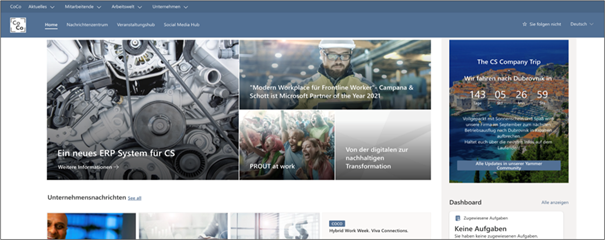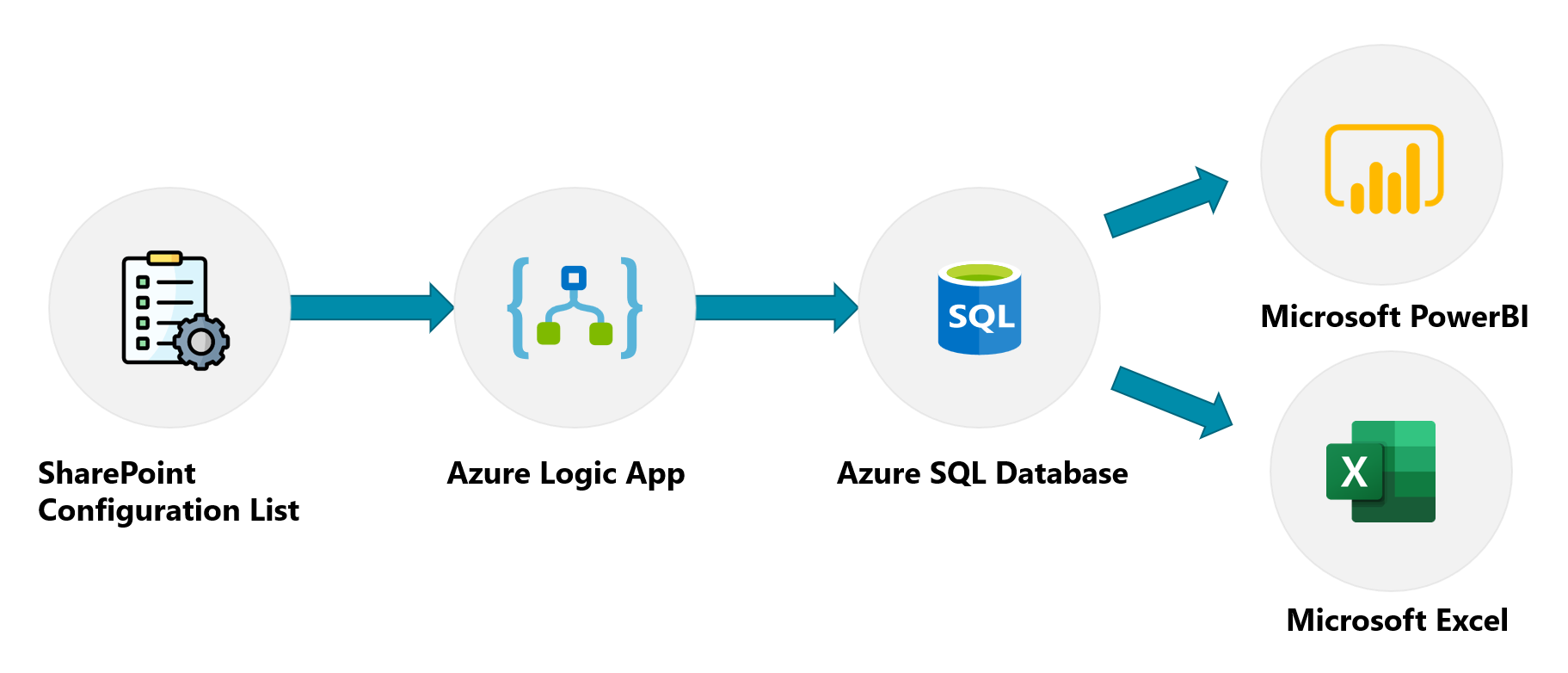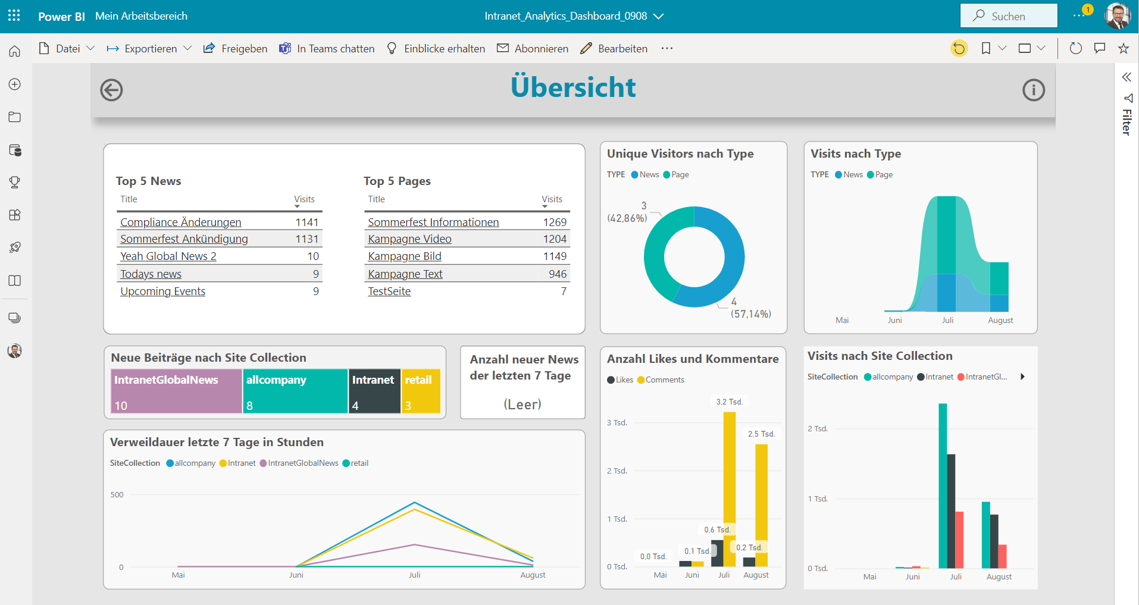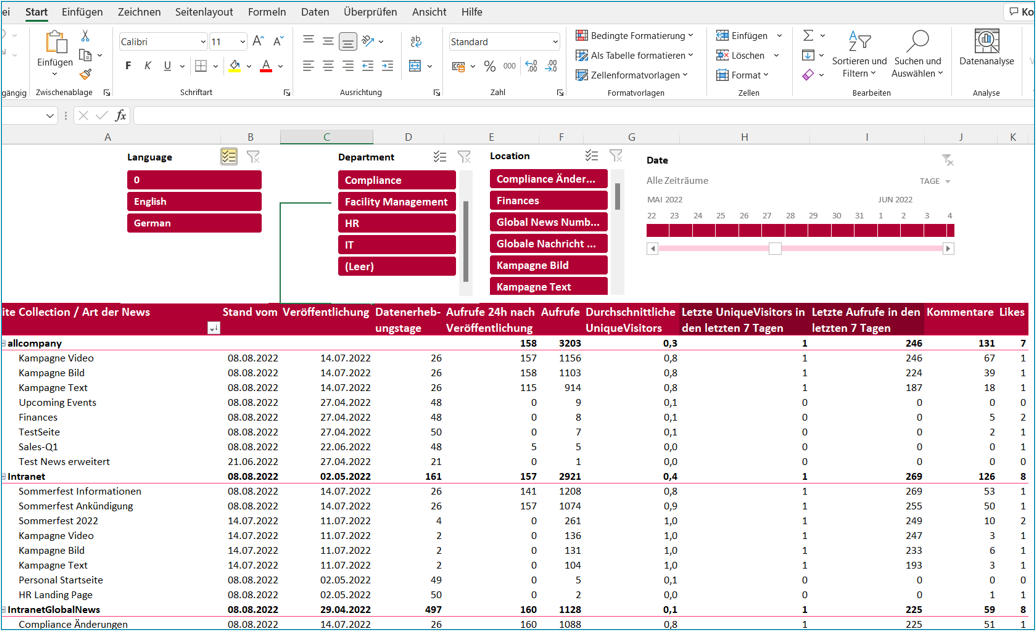If corporate communications want to measure the success and current maturity of the intranet in their responsibility, there are currently three options within the Microsoft 365 Cosmos:
- Using the standard analytics of SharePoint Online,
- licensing and introducing a third-party tool, or
- retrieve data manually from the intranet manually and visualize it in an Excelsheet or PowerPoint by a work student.
- Hand on heart – the third variant is not so rare!
But why is this the case – why do companies so often stick to manual data analysis? The answer is simple: There is no comprehensive, tenant-wide analytics of SharePoint usage data, including team sites and other sites that are not originally part of the intranet. The out-of-the-box analytics is very technical. Business related questions, such as those by corporate communication, are often not answered. Third-party tools and classic website analytics tools often hardly meet internal GDPR and data security requirements.
Together with IT and many specialist departments, corporate communication has given a lot of thought to how they want to set up their own intranet for employees – structure, message flow, content design, UI/UX. If this (pre-)work was carried out with rake and secateurs, the analytics of SharePoint and Microsoft nevertheless come from the harvester. Together with our customer, we show that this can be done smarter.
Intranet Analytics for Corporate Communication
In the evaluation of the standard analytics within SharePoint Online with our customer, it became clear that design aspects of the intranet are not sufficiently reflected in the KPIs and visualizations. We identified the following elements for our analytics approach as to be crucial for relevant business insights:
- News Pages, which are located in increasing numbers in various site collections, are created and published by various editorial teams. These news pages have other characteristics such as tags, which represent a topic or department assignment and can thus be played out at different locations in SharePoint.
- Pages that are listed in the navigation for the users – here we were mainly interested in entry pages for topics, areas, departments, so-called landing pages.
- All these pages have one thing in common: Via the existing interfaces in the Office Graph, we can retrieve relevant figures on visits, unique visitors, page visits, but also existing metadata such as creation date, tags, language, etc.
- Now corporate communications is also interested in social features. Comments and likes are an important indicator of the success of an intranet – and these numbers are currently only obtained by manual counting.
From a technical point of view, our Service consists of the following components:
- Using a SharePoint-based Microsoft List (commonly known as Sharepoint Online List), corporate communications can determine exactly which site collections are part of the intranet. Our focus here was on simplicity and extensibility – both as the intranet grows and when it uses additional features in later expansion stages.
- Based on this list, an Azure Logic app works its way through the growing content every day using the SharePoint REST API and the Graph API and writes the numbers to an Azure SQL database. At this point it should be mentioned that the service causes low costs in the company's own Azure subscription – usually these are well below 100 EUR / month.
Finally, any BI tool can tap into and display the data. We have developed both a Power BI dashboard and an Excel-based analysis. Advantages of our data model are these possibilities:
- Identification of accesses in the first 24 hours. This is a decisive measure in a corporate communication for the success of a published message, because most of the time the message can be found prominently on the homepage.
- Analytics for any period of time on a daily basis. How were the accesses to the content in the context of an event in the days before and after a few weeks ago? In the standard you will only find the last 7, 30 and 90 days.
- Absolute numbers in the context of the number of users. Example: if I count 1000 unique visitors, but want to inform 5000 employees, my news was not very successful.
- Multilingual news is counted individually in the standard – we combine them into a data set with different language variants.
Key Takeaway
We experience an increasing demand from our customers to build up the ability to measure and continuously improve their intranet. The built-in capabilities from SharePoint are falling short the requirements of Corporate Communication and IT departments. External providers on the other hand introduce new complexities with data compliance and requirement fit.
Two points stand out for us, we want to highlight here:
- There is a need for continuous improvement and business understanding, what data can be captured easily and how insights can be derived to support decision making in the business departments. As the Intranet becomes a more important, integral part of an overarching Digital Workplace effective communication and analytics-based decision making will be increasingly important. This becomes especially apparent, when considering more collaborative and communication tools than just a SharePoint-based Intranet – thinking about Yammer or Teams but also Microsoft Streams.
- From a technical point of view, many of our customers have agreements with Microsoft and are very hesitant to share data with additional providers. In our project, we developed with our customer a business-centered approach to analytics for corporate communications. Using standard toolset every enterprise knows and champions, such as relational databases (here Azure SQL database) and BI Tools (here Power BI and Excel), a lot can be achieved in short time. Best of all, this is a customized approach, meaning it can be adapted to the enterprise-specific needs and extended if complexities increase.
If you want to learn more, how you can approach analytics within your intranet with special emphasis on corporate communication, feel free to contact us and we will make an appointment.







